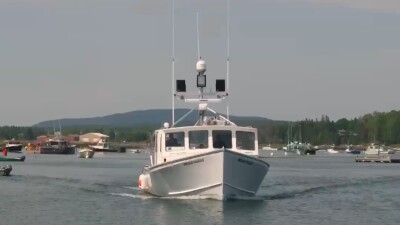On commercial fishing vessels, winches and booms are important for bringing products aboard. On the most basic level, a reel is a winch, and a rod is a boom, and that’s all bluefin tuna fishermen use when landing fish that can weigh more than half a ton.
With valuable fish on the line, literally, the equipment needs to be the best, and the choice of many champions these days are the Reel Easy, Trident 80-130 rod, and the Alutecnos, Albacore 130 2-speed reel.
Jeff Fontes and his father started building Reel Easy rods around 15 years ago, and as Fontes explains, the rods they make are the latest stage in a constant evolution.
“Starting in the ‘30s, tuna was mostly a sport fish, people were chasing giants, but in the 1980s there was a group called the Moonies, they had a whole fleet catching tuna to sell, and they would buy tuna from other commercial fishermen.”
“It was 5-foot, 6-inches long, very stiff. The short rods gave you more leverage, but they had to be stiff. These fish hit like a freight train, they hit at 60-miles an hour, they feel the hook, and then one of two things happen, they either break something, or you’re hooked and off to the races.”
Fontes notes that at this point, the reels began to change.
“Penn came out with the 130st, a two-speed reel—a high speed for when the fish is coming at you, and a low speed for when you need to lift the fish,” he says. “Then Shimano came out with the Tiagra 130, which was smoother, it had a better drag system, and the two-speed was push button.” New reels also came from makers such as Okuma, and an American Company, Accurate. Fontes notes, however, that an Italian-made reel, the Alutecnos, is finding favor with many New England tuna fishermen.
As the reels changed the rods too changed too, and that’s where Reel Easy created its niche.
“The fish got smarter,” says Fontes. “People found they were getting more bites on lighter gear and started to switch to 80-pound rods. These are longer, and they have a lot more flex.”

The problem, as Fontes describes it, is that the 80-pound rods have not been the best for getting fish aboard.
“They were seeing a lot of boatside losses after fighting a fish for hours. We were just coming into our own at the time, and we started talking to guys like Dave Carrera of tuna.com, and asking, what do you guys need? What can we do to get our rods on your boats?”
The answer turned out to be simple. Fishermen want the best of both. “So, my dad came up with the idea of a rod with the soft tip action of an 80 and the strong backbone and power of a 130,” says Fontes. “The rods start with blanks that we buy from a number of manufacturers. We went to a couple of them and told them what we needed. We told them these rods are going to be on TV on ‘Wicked Tuna’, and they absolutely cannot break. They have to be able to deadlift 100 pounds. That’s the drag pressure, and no reel out there can create 100 pounds of drag.”
According to Fontes, one of the companies came through with a prototype, and when they tested it, it withstood 194 pounds without breaking.
“We started building it, people started using it, and then word got out. If you want a rod with a soft tip but able to bring an 800-pound fish alongside the boat, the Trident 80-130 is it,” says Fontes. He and his father make the rods with several butts, from straight to bent to adjustable. “We got paired up with a company called Winthrop Tool in Connecticut, and they make guides a little bigger, so you can pass a swivel through them,” he says. “We use six of those plus the tip. They have flexibility built in, they come with roller or bearings, and they come in different colors.”
If the Trident 80-130 is the prime rod for the pros, the Alutecnos, Alabacore 130 2-speed is the reel. According to Mason Featherston, national sales manager for Alutecnos, most of the Wicked Tuna fishermen have Alutecnos reels.
“They like the quality of the machining, the quality of the gearing, and the simplicity of the design,” says Featherston. “The precision tolerances give you consistent breaking power when you have the big fish on.”

Manufactured in Monselice, a small city in northern Italy, the Albacore 130 2s, has a push button two speed on the crank handle, a lever drag adjuster, and other features.
“We use the best materials we can get,” Featherston says. “The bearings are made of German stainless steel. The gears are made of 3-16 stainless steel, which is hard and durable. The aluminum is 60-82 airplane-grade aluminum, and we’re very proud of our anodizing. You don’t see pitting or discoloring on our reels.”








